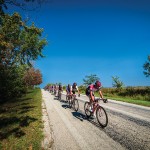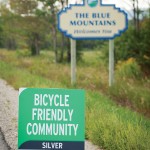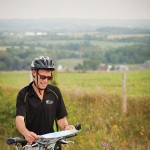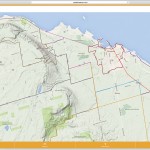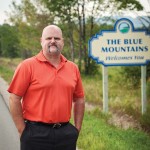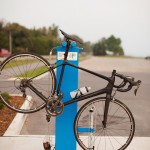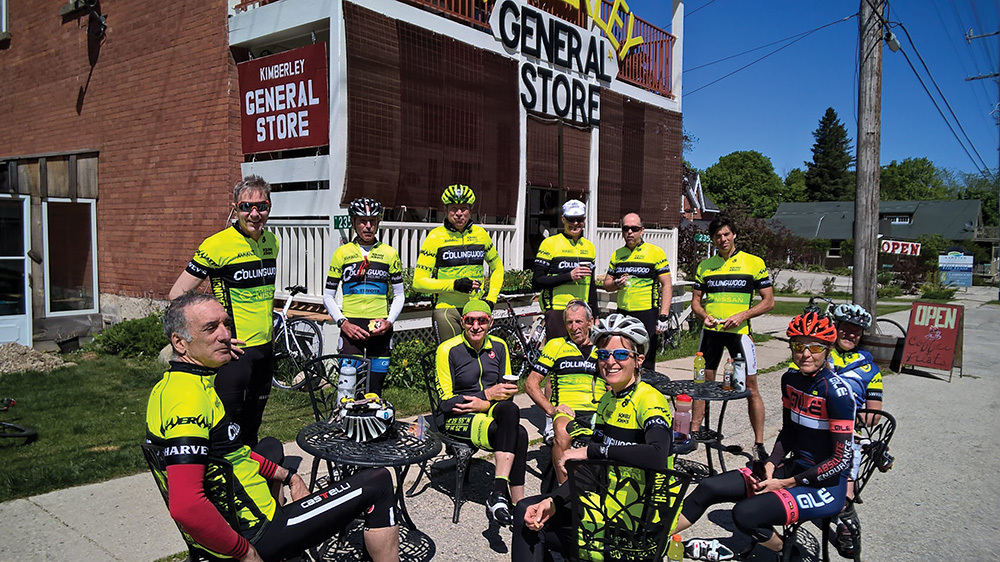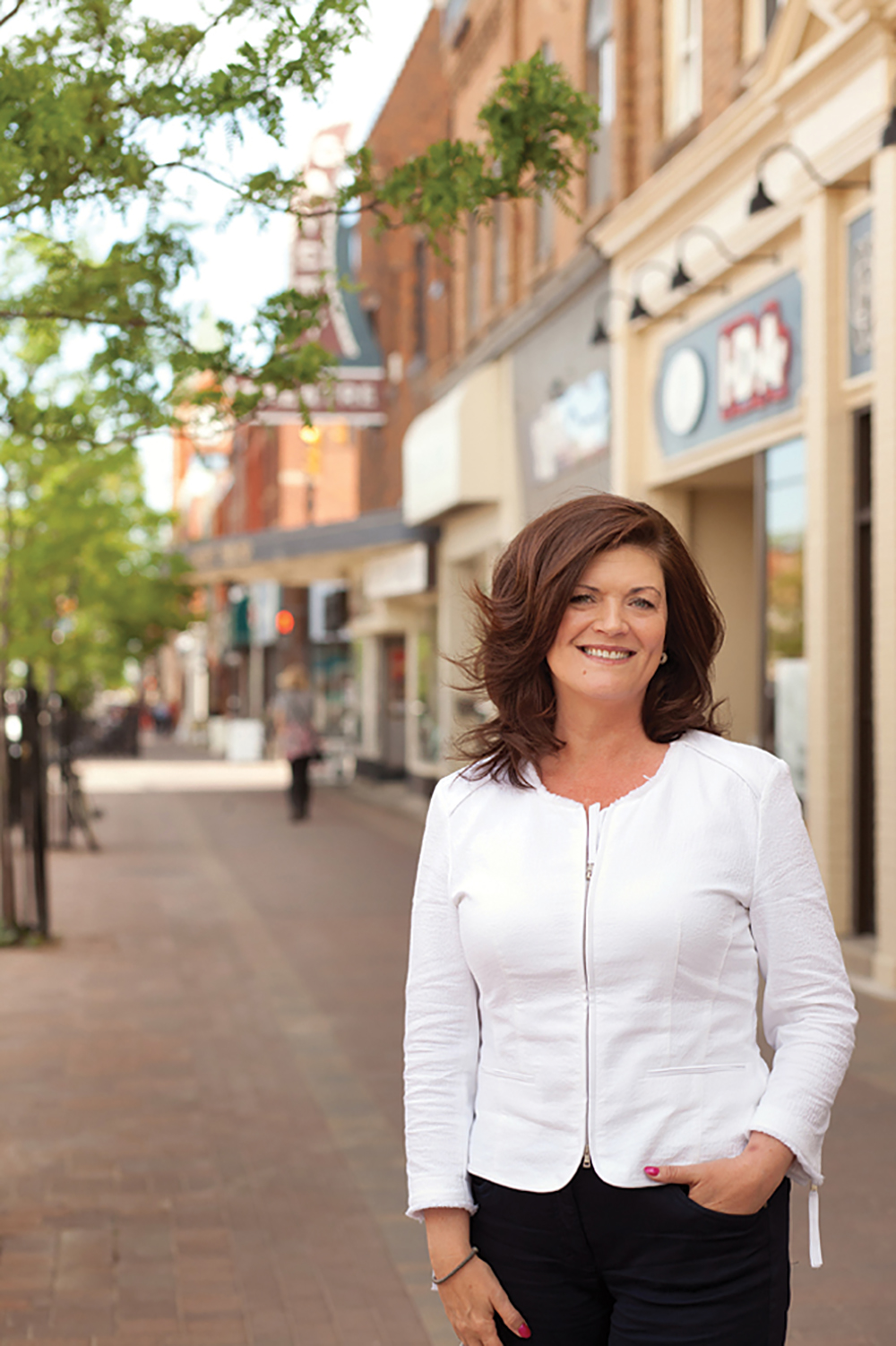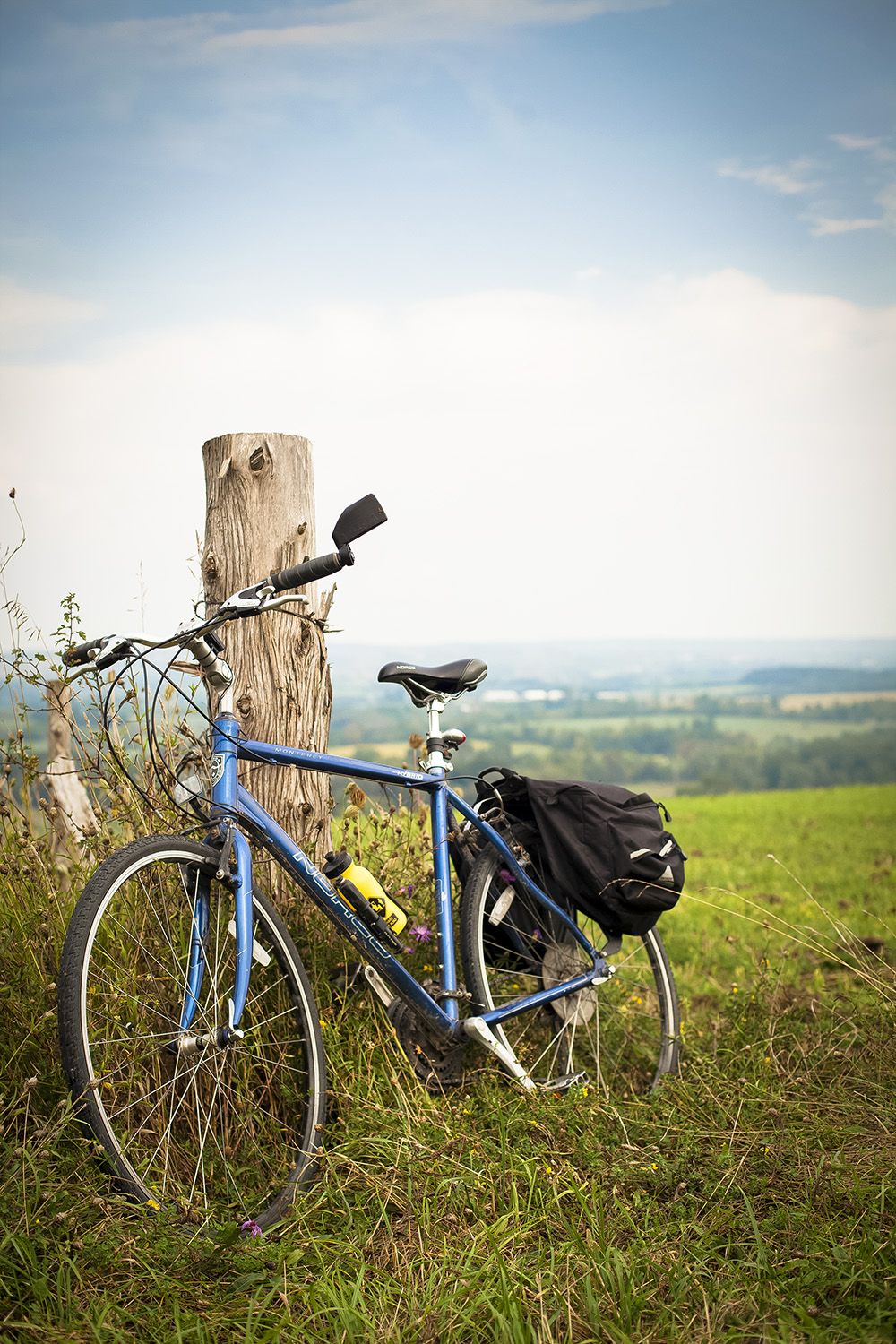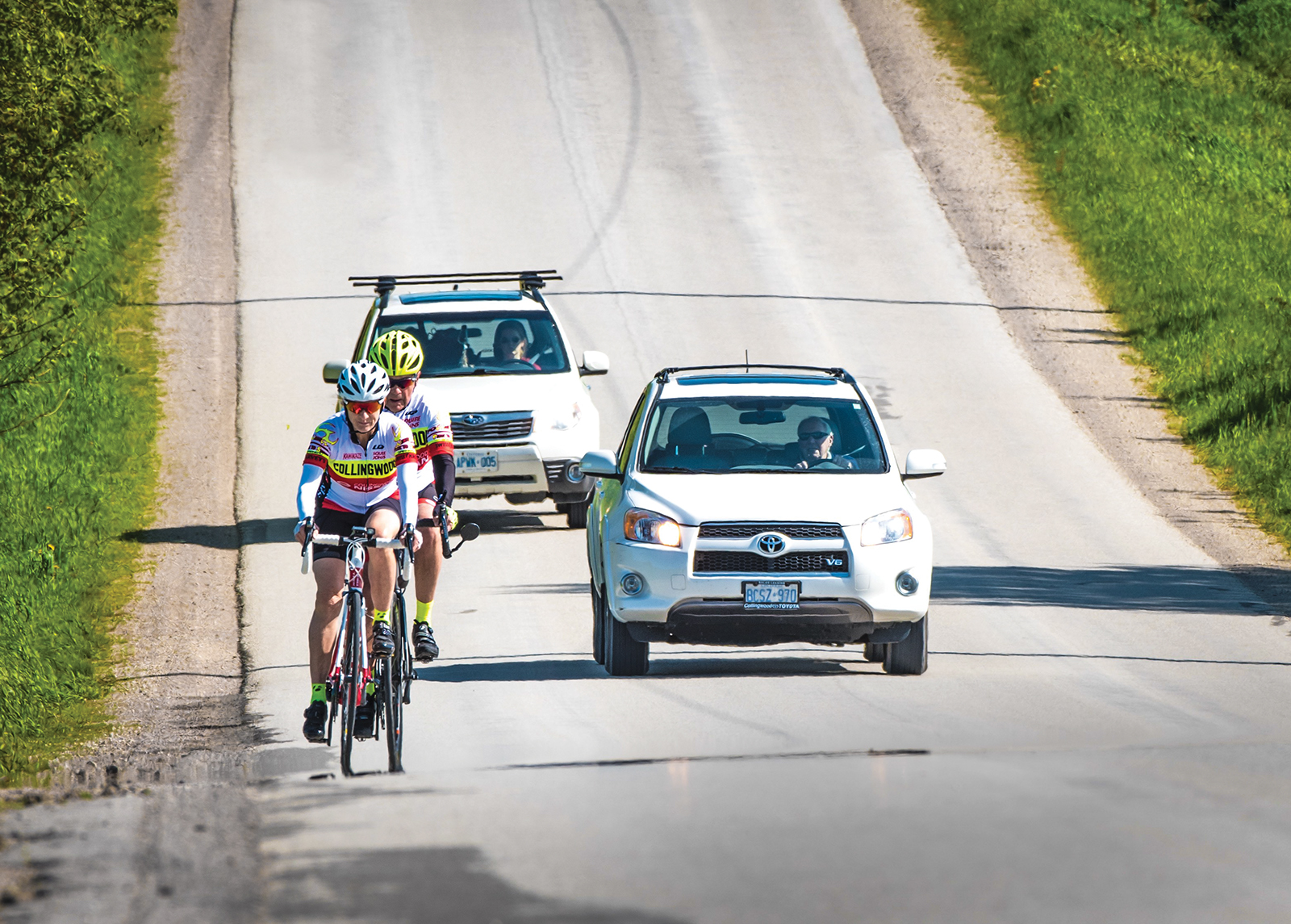Why cycling is booming in Southern Georgian Bay, what it means and what the future holds
by Janet Lees ❧ opening photo by Marc Landry
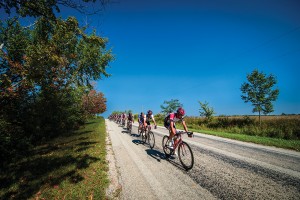
They’re an increasingly common sight on our roads; alone, in pairs or in packs, often wearing matching cycling club jerseys, pumping out the kilometres in pursuit of fitness, recreation, competition or the benefit of some good cause. They’re couples, families, sightseers, triathletes, racers and weekend warriors. They’re young (and young-ish) professionals, entrepreneurs and corporate types – both men and women – with disposable income to spend. They’re today’s road cyclists, and in ever greater numbers they are discovering that Southern Georgian Bay is an ideal place to ride.
When it comes to cycling, Southern Georgian Bay has it all: rolling hills, steep climbs, flat rail trails, stupendous views. Add in all the amenities a cyclist could want – from restaurants to spas, breweries, wineries, hotels, b&bs and shops – and it’s no wonder riders are flocking to the area.
This area has long been known for great mountain biking – both downhill and cross country – but it’s only in the past five years that road biking has really skyrocketed. That’s in large part because of events like Centurion Blue Mountains, billed as “Ontario’s biggest cycling race,” which began five years ago and today attracts thousands of cyclists to the area each September. Other races include the Grey County Road Race and the Grey County Time Trial, the only North American qualifiers for the UCI (Union Cycliste Internationale) World Cycling Tour. Once those cyclists discover the world-class riding available here, they keep coming back.
“We’ve really become a Mecca for cycling tourists, whether they’re coming to the area for a cycling event, a weekend ride or a cycling holiday,” says Brendan Matheson, cycling strategy coordinator for Simcoe County. “It’s a really exciting time right now; there’s a ton of buzz around cycling tourism.”
Matheson’s job itself is a testament to the importance being placed on cycling as an economic driver in the area. An avid cyclist and member of the Barrie Cycling Club (BCC), he was hired in 2013 as part of a partnership between the BCC, the County of Simcoe and the Township of Oro-Medonte. “The goal was to develop a county-wide cycling strategy, but do a test project in Oro-Medonte, then expand into one more municipality after two years. But it was such a success that two years in, we’re in 13-plus municipalities,” says Matheson. “Once we got started it just took off.”
The strategy, branded Cycle Simcoe, involves mapping out routes for cyclists, installing directional and safety signage, installing bike repair stations and improving the cycling infrastructure including upgrading road conditions and adding bike lanes in some areas.
Visitors to the Cycle Simcoe website (cyclesimcoe.ca) can now find interactive, mobile-friendly maps showing a variety of safe cycling routes throughout the county for all levels of cyclists. The maps are rated for difficulty and distance, and spotlight all of the nearby attractions and points of interest as well as bicycle-friendly businesses where riders can eat, shop or stay along each route.
“These interactive maps are pretty unheard-of in cycling tourism; we’re really ahead of the curve,” says Matheson. “You can open it up on your smart phone or android, choose a route, find out how long it is, follow the colour-coded bike signs as you ride the route, and at each point along the way you can find out where to stop for food, sight-seeing, attractions, accommodations … really anything you might need to have a great cycling experience.”
In another initiative, Cycle Simcoe is installing outdoor bicycle repair stations, designed to fit any bicycle type and containing all the tools required for minor maintenance and repairs, including a tire pump and pressure gauge. The first repair station was installed at Georgian College last spring and the second went into Sunset Point Park in Collingwood in the summer, with more slated for Wasaga Beach and across Collingwood. Businesses can also purchase repair stations for their cycling visitors to use. The plan is to have them throughout the county by the end of summer 2016.
The bike repair stations will also be installed in Grey County, and that’s the real key to the whole program, says Matheson – to ensure consistency throughout Southern Georgian Bay. “Cyclists don’t know and don’t care if they’re crossing a border from Simcoe County into Grey County, or from Collingwood into the Blue Mountains; they just want to ride,” he notes. “When cycling tourists come to the area they’ve got to have that consistent and memorable experience, whether they’re riding in Simcoe County or Grey or Bruce County.”
To that end, the three counties are working closely together and local municipalities are also on board, says Matheson.
Grey County, along with the area’s Regional Tourism Organization (RTO7), invested $40,000 in 2013/14 to research the cycling tourism market and identify opportunities. “We realized that the market we had at the time was what I would call the avid cyclists – the spandex crowd, the folks that are in the cycling clubs, that are competitive, love to ride, ride long distances, ride very quickly,” says Bryan Plumstead, economic development and tourism manager for Grey County. “These are the people who ride the Centurion, come to train… that’s probably been the biggest contributor to our tourism market. But we also saw another category – the leisure rider who might only ride 20 or 30 kilometres a day, goes a bit slower but really enjoys riding. That is a much bigger market but at the time we were getting much fewer of those riders, so we felt that was a real opportunity.”
The county, which already had an extensive network of cycling routes mapped out, worked with Ontario By Bike to develop six new routes in the 20-40 kilometre range.
“We developed those, we mapped them, and I think we’ve had some success in growing that market, but it’s probably going to take a few years and probably a bit more infrastructure to really capture that market.”
Infrastructure improvements may include more paved shoulders for added safety on some of the busier roads. At a cost of about $70,000/km to pave the shoulders, there has to be justification, says Plumstead, and that means quantifying the economic benefits cycling brings to the region. There is also provincial funding available through CycleON, Ontario’s cycling strategy to promote cycling across the province as a viable transportation option.
Plumstead, who puts himself and his wife firmly in the recreational/leisure rider category, says a recent cycling trip in Quebec showed him what is possible in our region. “I really think we can match Quebec in terms of what we can aspire to, but it’s going to take some careful investment in infrastructure,” he says. “We just have to set those priorities, but we have all the elements here.”
In addition to the county level, individual municipalities are also making cycling a priority when looking at road construction, infrastructure, signage, etc. The Blue Mountains in particular has been a leader in this regard, receiving a 2015 Silver Award as a bicycle-friendly community from the Share the Road Cycling Coalition.
“Council buying in so much with the cycling has probably been our biggest success,” says Shawn Everitt, director of community services for The Blue Mountains. “We’ve now had several terms of council that have continued to make cycling a priority. It’s definitely one of the checkmarks we have now whenever we review a project.”
As a result, the town is applying to CycleON for cycling infrastructure funding, including extra width on popular cycling roads such as 33rd Sideroad.
Martin Rydlo, Collingwood’s director of marketing and business development, says Collingwood is also making efforts to identify roads that can be upgraded for cyclists, including wider shoulders. “The Hume Street reconstruction includes a wider bike shoulder, and there will be wider bike shoulders on the Highway 26 reconstruction that’s currently going on,” says Rydlo, adding the roads department is even looking at details like keeping the shoulders clean and clear for cyclists, especially after the winter. “We need to continue challenging ourselves to build and maintain a good cycling community, and we’ve got some wonderful regional partners that are great role models,” says Rydlo.
He agrees with Plumstead and Matheson that collaboration and continuity are key to making the most of what our region has to offer cyclists and cycling tourists.
“I see it as such a huge opportunity to differentiate our region from a tourism standpoint, so working closely with the regional partners is absolutely essential,” he says. “Cyclists are big spenders – much moreso than runners or any number of other athletes, and that’s why it’s a good investment from a tourism standpoint for our entire region to jump on the opportunity of making this area cycling friendly.”
Get Your Bike On!
To find out more about cycling and cycle tourism in Southern Georgian Bay, including maps, routes, tours, events, cycling-friendly businesses, services and amenities, visit:
Cyclesimcoe.ca
Bikesouthgeorgianbay.ca
Brucegreysimcoe.com
Ontariobybike.ca
Read More:
Safety: It’s a Two-Way Street!
“Share the Road” is no longer just a catchy slogan – it’s the law Continue reading
Business Cycle
Local businesses are reaping the benefits of the cycling boom, and cyclists are reaping the benefits of an array of services and amenities Continue reading






